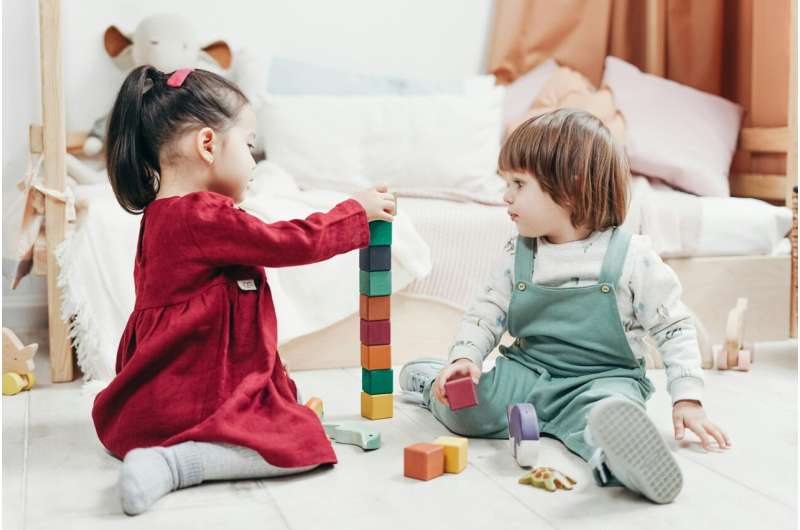

Income and wealth inequality in the U.S. remain near all-time highs. Analysts say this disparity is a “major issue of our time.” Experts have spotlighted deep policy failures fueling the problem and helpful economic fixes to alleviate the suffering.
Now researchers say our biases favoring the rich over the poor may take root earlier than was previously believed—perhaps when we are very young toddlers.
A new study led by a UC Berkeley psychologist suggests that biases towards those with more resources can be traced to beliefs formed as young as 14 months. However, researchers say a preference for richer people may not necessarily be driven by kids’ positive evaluations of them.
Instead, it might be caused by a negative assessment of those with less.
“Taken together, this suggests that somewhere early in this second year of life—12 to 15 months of age—we’re really seeing the development of these wealth-based biases come into play,” said Arianne Eason, a UC Berkeley assistant professor of psychology and the paper’s lead author. “And once they come in, they are relatively strong.”
The research findings were published this month in the Journal of Experimental Psychology: General.
Through a series of seven experiments, the team measured how toddlers demonstrated preferences for people with differing amounts of particular kinds of resources they desired—toys and snacks. Besides a bias toward the more “wealthy” person who had more resources, the children showed dislike and avoidance of those whom researchers labeled in the experiments as the “poorer” individuals.
Together, the results point to the deep-seated ways humans form ideas about what to value.
The research was partly inspired by Eason’s previous work with children. In graduate school, Eason worked in a lab that studied how infants and children thought resources were and should be distributed. That research consistently demonstrated that young toddlers and preschoolers generally preferred people who distributed resources equally. Wealth-based biases, in contrast, were thought at the time to emerge later in development, perhaps through direct conversations and socialization.
But Eason increasingly wondered less about how people distribute resources and more about how children understood the mere possession of them. To find answers, Eason and her collaborators focused on young children at an age when learning about the social world happens rapidly.
To begin, they needed to determine whether toddlers even retained information about who had more items that were a proxy for “wealth.” They introduced 35 children to two people in a room, both of whom had a clear bowl. One of the bowls was filled with things like toys or snacks; the other was almost empty.
Later, each person brought out a new bowl and left the room. This time, though, the bowls were opaque. While the participants couldn’t see how many items were in the bowls—or if there were any toys or snacks at all—they were significantly more likely to select the bowl belonging to the person who had previously had more. It was clear that the young toddlers could retain that information.
Next, researchers wanted to test what they did with the knowledge and how it factored into deciding who to help when grown-ups had a shortage of resources—in this case, blocks to build a tower. Toddlers were more likely to choose the person who earlier in the study had more resources. That indicated a longer-lasting preference for those individuals who were wealthier.
Over and over, the children showed that they tracked wealth, preferred to help those who were richer and were more likely to play with those who had more resources.
The rich kept coming out ahead.
“It’s very clear that toddlers can track well and have these behavioral preferences in favor of people who have more,” Eason said, adding that the effects were diminished for those younger than about 13 months of age.
The team then tracked the eye movements of the young toddlers as a video played on a screen. An adult on the screen doled out unequal amounts of resources—Legos and crackers, this time. Initially, the children’s gaze was barely different. But then they listened to either a positive recording that said of the adult in the video, “She’s a good girl, she did a good job,” or a negative one that said, “She’s a bad girl, she did a bad job.”
The ones who heard the positive message spent their time looking equally at the rich and the poor individuals. Meanwhile, those in the negative message group focused more of their attention on the poorer person.
“It’s not that toddlers had a preference for rich people,” Eason said. “They may have actually had a dispreference for poor people.”
Eason and her co-authors say their work shows that undoing wealth inequality will require a concentrated effort among adults to change the way young children think about and act toward poorer people. That must happen, they say, with the help of people and institutions in the kids’ lives who can help combat the negative attitudes that children begin noticing around the time they’re learning to walk.
“These are early-ingrained tendencies,” Eason said. “That means we have to work hard to undo them and put in a lot of concerted effort. But that doesn’t mean we should shy away from it.”
To be sure, part of the wealth-based bias could be linked to evolution, she said. Perhaps humans naturally gravitate toward those with resources that will help keep them alive.
But Eason said there’s more at play. Her research points to systemic ways we should begin thinking about inequality, and the origin of that wealth-based bias “starting point.” That’s the only way to combat the biases among many adults that benefit the wealthy and perpetuate policies against the poor.
“Just because wealth biases occur in the second year of life doesn’t mean that that has to be the way the world is,” Eason said. “We are highly flexible as people. We can build policies that go against some of our initial tendencies in order to create the outcomes we want to see.”
More information:
Arianne E. Eason et al, The haves and have-nots: Infants use wealth to guide social behavior and evaluation., Journal of Experimental Psychology: General (2024). DOI: 10.1037/xge0001567
Provided by
University of California – Berkeley
Citation:
Can toddlers help explain the origins of our bias for wealth? (2024, September 18)
retrieved 18 September 2024
from https://phys.org/news/2024-09-toddlers-bias-wealth.html
This document is subject to copyright. Apart from any fair dealing for the purpose of private study or research, no
part may be reproduced without the written permission. The content is provided for information purposes only.